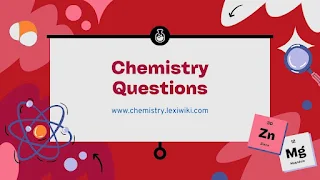Questions on Chemical Change
Multiple-Choice Questions – Chemical Change
1. What is a chemical change?
A) Change in shape
B) Change in color without new substances
C) Formation of new substances with different properties
D) Change of state (solid to liquid)
E) Dissolving a solid in a liquid
2. Which of the following is an example of a chemical change?
A) Ice melting
B) Sugar dissolving in water
C) Burning paper
D) Boiling water
E) Crushing a rock
3. Which of the following indicates a chemical change?
A) Change in mass
B) Change in temperature or energy
C) Change in volume only
D) Change in shape only
E) Change in physical state only
4. During a chemical change, what happens to the original substances?
A) They disappear
B) They transform into new substances
C) They remain unchanged
D) They evaporate
E) They freeze
5. Which of the following is a sign of a chemical change?
A) Melting
B) Freezing
C) Color change
D) Boiling
E) Dissolving
6. Which of these is NOT a chemical change?
A) Rusting of iron
B) Burning of wood
C) Melting of ice
D) Baking a cake
E) Digesting food
7. What is released or absorbed during a chemical change?
A) Only light
B) Only sound
C) Energy
D) Only matter
E) Only heat
8. When iron rusts, it reacts with:
A) Oxygen and water
B) Nitrogen only
C) Carbon dioxide only
D) Hydrogen only
E) Helium
9. Which process is an example of chemical change?
A) Boiling water
B) Dissolving salt
C) Photosynthesis
D) Melting wax
E) Tearing paper
10. In chemical change, bonds between atoms are:
A) Created only
B) Broken only
C) Broken and new bonds formed
D) Never affected
E) Formed into ions only
11. When a candle burns, what type of change is taking place?
A) Physical change
B) Chemical change
C) Phase change
D) Reversible change
E) No change
12. Which of the following statements is true about chemical changes?
A) They are always reversible
B) They produce new substances
C) No energy is involved
D) They change physical state only
E) They involve changes in size only
13. The formation of bubbles in a reaction indicates:
A) Physical change
B) A chemical change producing gas
C) Change of temperature
D) Change in color
E) Melting
14. Combustion is an example of:
A) Physical change
B) Chemical change
C) Mixture formation
D) Dissolving process
E) Boiling process
15. Which of the following is an example of chemical change that produces a solid?
A) Dissolving sugar in water
B) Formation of a precipitate
C) Melting ice
D) Evaporation of water
E) Sublimation of dry ice
16. Which is a chemical property that indicates chemical change?
A) Melting point
B) Density
C) Reactivity with oxygen
D) Boiling point
E) Color
17. Which of these reactions is a chemical change?
A) Water freezing
B) Metal rusting
C) Ice melting
D) Salt dissolving
E) Sand mixing with water
18. Which of the following is NOT true about chemical changes?
A) New substances are formed
B) Energy changes occur
C) Mass is conserved
D) It can be reversed easily by physical means
E) Bonds between atoms are rearranged
19. What happens to energy during an exothermic chemical change?
A) Energy is absorbed
B) Energy is released
C) No energy change
D) Energy disappears
E) Energy is stored only
20. Which of the following can result from a chemical change?
A) Change in odor
B) Change in temperature
C) Formation of gas
D) Formation of precipitate
E) All of the above
Answer Key with Explanations
1. C) Chemical change results in new substances with new properties.
2. C) Burning paper produces new substances (ash, gases).
3. B) Energy changes (heat/light) indicate chemical change.
4. B) Original substances transform chemically into new ones.
5. C) Color change often signals chemical reaction.
6. C) Melting is a physical change, not chemical.
7. C) Energy is either absorbed or released during chemical change.
8. A) Rusting requires oxygen and moisture.
9. C) Photosynthesis is a chemical change producing glucose.
10. C) Bonds are broken and new bonds formed in reactions.
11. B) Burning candle wax is a chemical change.
12. B) Chemical changes produce new substances.
13. B) Bubbles indicate gas formation in chemical reaction.
14. B) Combustion is a chemical reaction producing heat/light.
15. B) Precipitate formation is a chemical change producing solid.
16. C) Reactivity with oxygen is a chemical property.
17. B) Rusting is chemical change; others are physical.
18. D) Chemical changes cannot easily be reversed physically.
19. B) Exothermic reactions release energy.
20. E) All listed options are signs of chemical change.
Dive into the groundbreaking science of neurotransmitters—your brain’s invisible architects—in Chemical Harmony: How Neurotransmitters Shape Our Lives (2025). This meticulously researched book reveals how serotonin, dopamine, GABA, and other brain chemicals silently orchestrate every aspect of your existence, from decision-making and relationships to mental health and emotional resilience.Click here to buy
Share Online!

